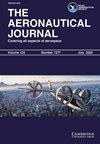An experimental study of transition and the development of turbulence in a linearly retarded boundary-layer flow
IF 1.6
4区 工程技术
Q2 ENGINEERING, AEROSPACE
引用次数: 2
Abstract
Abstract An experimental investigation was carried out of the incompressible boundary layer flow along a flat plate, in the presence of an adverse pressure gradient that corresponds to a linear retardation of the free stream velocity. The turbulence level in the free-stream was 0·12% and transition occurred with the laminar boundary layer being close to separation. For three values of the Reynolds number (2·56, 3·11 and 4·09 million based on the reference length that is defined as the reciprocal of the nondimensional-velocity gradient) the laminar, transitional and turbulent regions were studied by single (normal) hot-wire surveys at several streamwise positions. This allows the fluctuations of the streamwise velocity component to be followed from the amplification of laminar instability waves, through breakdown in the intermittency region, and the subsequent development towards a more or less developed turbulence structure. The study reveals that within the transition region fluctuation levels are reached throughout a large part of the boundary layer that are significantly higher than those in fully developed turbulent flow, which is partly a direct consequence of the intermittent character of the flow. For the highest Reynolds number additional cross-wire surveys were carried out in the turbulent region to observe the development of the turbulent stresses following transition. The data are interpreted in terms of structural coefficients, eddy viscosity and mixing length. Also, these results indicate that the transition process can be associated with turbulence levels well in excess of those occurring in fully developed turbulence, and reveal the relaxation of the outer region turbulence structure.线性延迟边界层流动过渡与湍流发展的实验研究
摘要:在自由流速度线性滞后的逆压梯度存在下,对平板上不可压缩边界层流动进行了实验研究。自由流湍流度为0.12%,层流边界层接近分离时发生了过渡。在三个雷诺数值(基于参考长度(定义为无因次速度梯度的倒数)为2·56、3·11和4·09万)时,通过在几个流向位置的单次(正常)热线测量研究了层流、过渡和湍流区域。这使得沿流速度分量的波动可以从层流不稳定波的放大,通过间歇区域的击穿,以及随后向或多或少发达的湍流结构发展。研究表明,在过渡区内,边界层的大部分区域都达到了明显高于完全发展的湍流的波动水平,这在一定程度上是流动间歇性的直接结果。对于最高雷诺数,在湍流区进行了额外的交叉线测量,以观察过渡后湍流应力的发展。数据用结构系数、涡流粘度和混合长度来解释。此外,这些结果表明,过渡过程可以与湍流水平相关联,远远超过发生在充分发展的湍流水平,并揭示了外部区域湍流结构的松弛。
本文章由计算机程序翻译,如有差异,请以英文原文为准。
求助全文
约1分钟内获得全文
求助全文
来源期刊

Aeronautical Journal
工程技术-工程:宇航
CiteScore
3.70
自引率
14.30%
发文量
86
审稿时长
6-12 weeks
期刊介绍:
The Aeronautical Journal contains original papers on all aspects of research, design and development, construction and operation of aircraft and space vehicles. Papers are therefore solicited on all aspects of research, design and development, construction and operation of aircraft and space vehicles. Papers are also welcomed which review, comprehensively, the results of recent research developments in any of the above topics.
 求助内容:
求助内容: 应助结果提醒方式:
应助结果提醒方式:


